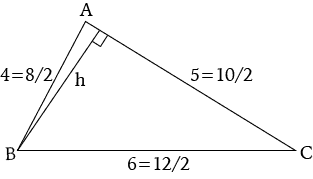It so happens that the triangle whose sides are 4, 5, and 6 has a special property: its largest angle is twice its smallest angle. Make calculations that support this assertion.
Solution Let ∠ A \angle A ∠ A ∠ C \angle C ∠ C
First Solution. We can use the law of cosines—twice.
6 2 = 4 2 + 5 2 − 2 ⋅ 4 ⋅ 5 cos A cos A = 6 2 − 4 2 − 5 2 − 2 ⋅ 4 ⋅ 5 = 0.125 ∠ A = arccos ( 0.125 ) ≈ 82.82 ° \begin{aligned}6^2 &= 4^2 + 5^2 - 2 \cdot 4 \cdot 5 \cos A \\\cos A &= \dfrac{6^2 - 4^2 - 5^2}{-2 \cdot 4 \cdot 5} = 0.125 \\\angle A &= \arccos(0.125) \approx 82.82°\end{aligned} 6 2 cos A ∠ A = 4 2 + 5 2 − 2 ⋅ 4 ⋅ 5 cos A = − 2 ⋅ 4 ⋅ 5 6 2 − 4 2 − 5 2 = 0.125 = arccos ( 0.125 ) ≈ 82.82°
4 2 = 5 2 + 6 2 − 2 ⋅ 5 ⋅ 6 cos C cos C = 4 2 − 5 2 − 6 2 − 2 ⋅ 5 ⋅ 6 = 0.75 ∠ C = arccos ( 0.75 ) ≈ 41.41 ° \begin{aligned}4^2 &= 5^2 + 6^2 - 2 \cdot 5 \cdot 6 \cos C \\\cos C &= \dfrac{4^2 - 5^2 - 6^2}{-2 \cdot 5 \cdot 6} = 0.75 \\\angle C &= \arccos(0.75) \approx 41.41°\end{aligned} 4 2 cos C ∠ C = 5 2 + 6 2 − 2 ⋅ 5 ⋅ 6 cos C = − 2 ⋅ 5 ⋅ 6 4 2 − 5 2 − 6 2 = 0.75 = arccos ( 0.75 ) ≈ 41.41°
Voila!
Second Solution. First we find the area, A \mathcal{A} A s s s s = 15 / 2 s = 15/2 s = 15/2
A = s ( s − a ) ( s − b ) ( s − c ) , = 15 2 ⋅ 3 2 ⋅ 5 2 ⋅ 7 2 = 15 7 4 . \begin{aligned}\mathcal{A} &= \sqrt{s (s - a)(s - b)(s - c)}, \\&= \sqrt{\dfrac{15}{2} \cdot \dfrac{3}{2} \cdot \dfrac{5}{2} \cdot \dfrac{7}{2}} = \dfrac{15 \sqrt{7}}{4}.\end{aligned} A = s ( s − a ) ( s − b ) ( s − c ) , = 2 15 ⋅ 2 3 ⋅ 2 5 ⋅ 2 7 = 4 15 7 .
Now we can find the height, h h h
15 7 4 = A = b h 2 = 5 h 2 \dfrac{15 \sqrt{7}}{4} = \mathcal{A} = \dfrac{bh}{2} = \dfrac{5h}{2} 4 15 7 = A = 2 bh = 2 5 h
it follows that h = 3 7 2 h = \dfrac{3 \sqrt 7}{2} h = 2 3 7
sin A = h / 4 = 3 7 8 ∠ A ≈ 82.82 ° \begin{aligned}\sin A &= h/4 = \dfrac{3 \sqrt 7}{8} \\\angle A &\approx 82.82° \\\end{aligned} sin A ∠ A = h /4 = 8 3 7 ≈ 82.82°
sin C = h 6 = 3 7 12 ∠ C ≈ 41.41 ° \begin{aligned}\sin C &= \dfrac{h}{6} = \dfrac{3 \sqrt 7}{12} \\\angle C &\approx 41.41°\end{aligned} sin C ∠ C = 6 h = 12 3 7 ≈ 41.41°
Hey! These solutions are a good advertisement for the law of cosines, don't you agree?
